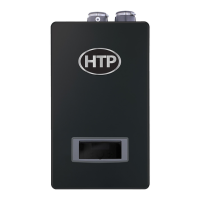5
LP-495 Rev. 1.21.16
A. BEFORE OPERATION
1. Check the Gas Type (NG/LP)
When operating the appliance for the first time, ensure the connected gas type matches that of the gas type of the appliance.
Check whether the gas supplied is NG or LP. The appliance gas type is indicated on the rating plate on the side of the
appliance.
Attempting to operate this appliance on a gas supply other than specified on the rating plate will result in improper appliance operation,
and could result in property damage or personal injury.
2. Check the Power (120V 60Hz)
Ensure the appliance is connected to a properly rated power supply.
3. Check the Cold Water Inlet Valve
Ensure the cold water inlet valve to the domestic hot water (DHW) loop is open and providing the proper pressure. The
appliance will not operate if there is insufficient water supply.
4. Check the Automatic Feed Valve
Ensure the automatic feed valve to the appliance is providing the proper pressure to the central heating (CH) loop.
5. Check the Gas Shut-Off Valve
Ensure the manual gas shut-off valve is open. The appliance will not operate unless it is supplied with gas.
6. Check the Area around the Appliance
Remove any combustible or flammable materials from the area around the appliance and do not hang anything from the
exhaust vent pipe.
Do not operate the appliance if its combustion air intake is located in or near one of the areas or in the vicinity of products listed in Table
1. These areas will always contain hazardous contaminates that can form strong acids while passing through the burner and vent
system. These acids will corrode the appliance’s heat exchanger, burner components and vent system, resulting in flue gas spillage
and/or water leakage, possible substantial property damage, severe personal injury, or death. If the appliance combustion air intake is
located in any area likely to cause or contain contamination, or if products which would contaminate the air cannot be removed, the
intake must be re-piped and terminated to another location.
DO NOT re-pipe the combustion ventilation system on your own. Call a qualified service provider for assistance.
AREAS LIKELY TO HAVE CONTAMINANTS
Spray cans containing fluorocarbons
Dry cleaning/laundry areas and establishments
Chlorinated waxes/cleaners
Chlorine-based swimming pool chemicals
Calcium chloride used for thawing
Refrigeration repair shops
Sodium chloride used for water softening
Paint or varnish removers
Plastic manufacturing plants
Hydrochloric or Muriatic acid
Furniture refinishing areas and establishments
New building construction
Antistatic fabric softeners used in clothes dryers
Chlorine-type bleaches, laundry detergents, and cleaning solvents
Adhesives used to fasten building products
Table 1
B. DURING OPERATION
1. Check for Gas Leaks
Frequently check the gas pipe and connections for leaks with a soapy solution. If air bubbles appear during the test, gas is
leaking. Close the gas supply valve and call your gas supplier for inspection.
After any repair of the gas pipeline or replacement of the gas regulator, call a qualified service technician to observe the installation and
replacement before restoring power to the appliance. Failure to do so could result in a fire or explosion, substantial property damage,
severe personal injury, or death.

